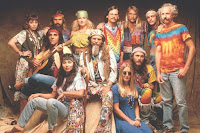Ashley Wells, Dhr. Seven, Sheldon S., CC Liu (eds.), Wisdom Quarterly Wiki edit
Number of Buddhists
Accurate counts of Buddhists in the United States are difficult. Self-description has pitfalls. Because Buddhism is a cultural concept, individuals who self-describe as "Buddhists" may have little knowledge or commitment to Buddhism as a formal religion or meditative practice.
On the other hand, others may be deeply involved in meditation and committed to the Buddha-Dharma but may avoid or refuse another religious label like "Buddhist."
In the 1990s, Columbia University Prof. Robert A. F. Thurman (Uma Thurman's dad and close friend of the Dalai Lama) estimated there were 5,000.000 to 6,000,000 Buddhists in America.
In a 2007 Pew Research Center survey, at 0.7% Buddhism was the third largest religion in the US after nominal Christianity [Christian in name only] (78.4%, most of them Catholic), no religion (10.3%), and Judaism (1.7%) [120].
- [There are about 300 to 333 million people in the USA. Some say, and this may be too hard for most Americans to believe, that there have never been even one million US Jews. The number, now at its highpoint, may only be 800,000. There are far more Muslims than that, and hardly anyone knows a Muslim. Most Jews are not recognizable as such. It is a religion, a cultural identity, a race, a club, a network, a haplotype, and a bad word no one can call somebody else without risking getting in a lot of trouble. Because Jews are so disproportionately represented in the media, faculty, and business, it just seems there must be millions and millions of them. That's how all social minorities are viewed. Social psychology has a demonstration experiment to prove it: Ask someone, your uncle or a stranger at school, "How many Jews are there? How many Latinos? How many Asians? How many Blacks? How many Middle Easterners? Add up the percentages. It will be higher than 100%, and we haven't even gotten to how many Anglos there are, which is the numerical majority. It has always been nauseating that in the university, the school paper was crying that "whites will soon be in the minority." How were they counting? It's far and away the largest group, even now decades later. They were adding up every other race into one lump and themselves into the other lump. When we become only 49% of the country (and who knows where the blended/mixed race people are being lumped), the "minorities" will be the majority. For everything else, everyone is segregated in the Four Food Groups of color, ignoring the reds and pinks, beiges and blends. We're either white, brown, yellow, or Black. That's all there is, and much like Mexico and Latin America under Spanish influence, it isn't really about race so much as it is about looks: shadeism.]
- 12 Things That Ruined Religion (msn.com)
In 2012 on the occasion of a visit from the Dalai Lama, U-T San Diego said there are 1.2 million Buddhist practitioners in the US, and of them 40% live in Southern California [121]. [Hooray for the Golden State!]
In 2008 the "Pew Forum on Religion and Public Life Religious Landscape Survey" estimated American Buddhists at 0.7% of the American population. During the same year the American Religious Identification Survey (ARIS), estimated this same figure at 0.5%. ARIS estimated that the number of adherents rose by 170% between 1990 and 2000, reaching 1.2 million followers in 2008 [122]. According to William Wilson Quinn "by all indications that remarkable rate of growth continues unabated" [123].
But according to Robert Thurman, Scholars are unsure whether the reports are accurate, as Americans who might dabble in various forms of Buddhism may not identify themselves as Buddhist on a survey. That makes it difficult to quantify the number of Buddhists in the United States [122].
Others argued, in 2012, that Buddhists made up 1 percent of the American population (about three million people).[79] By the year 2050 Buddhism is projected to become the third largest major religious group in North America, after Christianity and Islam [124].
Demographics of Americans who become Buddhists
A sociological survey conducted in 1999 found that relative to the US population as a whole, Buddhist converts are proportionately more likely to be white, upper middle class, highly educated, and left-leaning in their political views.
In terms of race, only 10% of survey respondents indicated they were a race other than white, a matter that has been cause of some concern among Buddhist leaders.
Nearly a third of the respondents were college graduates. More than half held advanced degrees. [As in the past, it's the influential and educated (in the past the royals) in a society who take the first interest in what the historical Buddha taught, often referred to as the Dharma.
 |
| See you in yoga, Mic? - I'll be in the temple-dojo. |
New Buddhists were also proportionately more likely to have come from Catholic or Jewish backgrounds.
[Why would this be? There are more Catholics to begin with, as the largest religion/sect in the world. Trying to explain Jewish interest in Buddhism, yoga, or Hinduism is a little more difficult to decipher. Like Jesus (Jewish Issa or Joshua or "Son of Zeus"), their cultural trappings left them free and yearning for authentic and direct spiritual experiences. Most Jews, particularly American ones, are Jewish in a cultural or relational sense, not in a religious or spiritual sense. It used to seem odd that so many Jews took a particular interest in the Tibetan Vajrayana tradition until one notices how many are avid vipassana or Theravada "insight meditation" advocates and yoga practitioners.
 |
| American JewBu: Change |
 |
| Future Buddha (Maitreya) as a Central Asian king |
More than half of these adherents came to Buddhism through reading books or other written material on the topic, with the rest coming by way of martial arts and friends or acquaintances.
The average age of the respondents was 46. Daily meditation was their most commonly cited Buddhist practice, with most meditating 30 minutes a day or more [125].
In 2015 a Pew Foundation survey found 67% of American Buddhists were raised in a religion other than Buddhism [126]. Of these, 61% said their spouses had a religion other than Buddhism [126].
The survey was conducted only in English and Spanish, so it may under-estimate Buddhist immigrants who speak Asian languages.
A 2012 Pew study found that Buddhism is practiced by 43% of surveyed Vietnamese Americans, 25% of Japanese, 15% of Chinese, 6% of Koreans, and 1% of Filipinos [127]. More







No comments:
Post a Comment